#Upper Triassic
Explore tagged Tumblr posts
Photo

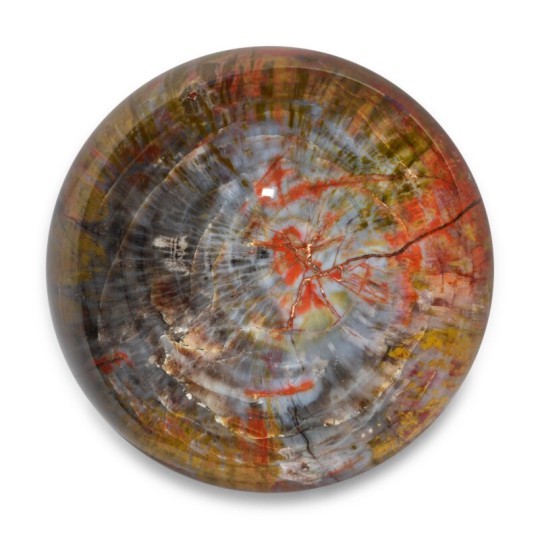
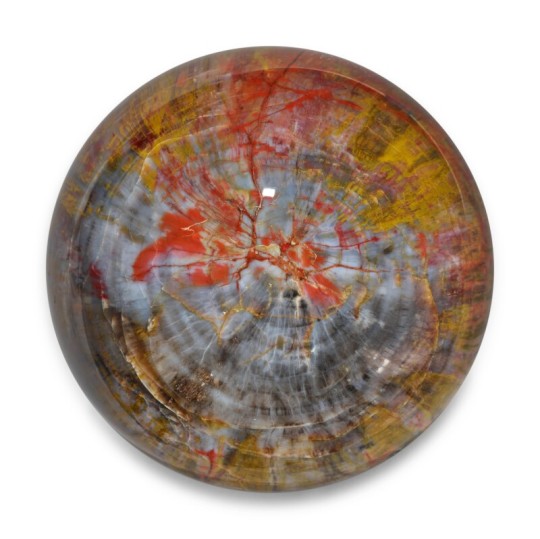

Petrified Wood Sphere Auricarioxylon arizonicum Upper Triassic – 220 million years old Chinle formation, Apache County, Arizona, USA
Finely polished, measuring 8 inches in diameter.
Petrified wood from the famed Chinle Formation near Winslow, Arizona is sometimes referred to as "rainbow wood” due to the large variety of colors which are all naturally produced over time by mineral replacement on a cellular level. Different minerals which seep into the fossilizing wood produce different colors.
In this wondrous example the riot of colors present include orange, yellow, and cream with splashes of blue/grey. Also noteworthy are the well-defined original growth rings, which are a testament to the outstanding preservation.
#Petrified Wood Sphere#Auricarioxylon arizonicum#Upper Triassic#Chinle formation Apache County Arizona#fossil#archeology#archeolgst#pretty#beauty#beautiful#history#history news#ancient history
6 notes
·
View notes
Text

Drepanosaurs were a weird little group of tree-climbing Triassic reptiles with prehensile claw-tipped tails, chameleon-like bodies, humped backs, grasping feet, long necks, and somewhat bird-like skulls that may have been tipped with toothless beaks in some species.
Recently some of them have been recognized as also having adaptations for digging and ripping into insect nests, similar to modern anteaters, with highly specialized forelimb bones and a massively enlarged hoked claw on each hand.
And now we have another one of these digging drepanosaurs: Unguinychus onyx, whose name delightfully translates to "claw claw claw"!
Living in what is now New Mexico, USA during the late Triassic, around 215-208 million years ago, Unguinychus is only known from its enlarged hand claws but was probably similar in size to some of its close relatives, likely around 40cm long (~1'4").
Based on skin impressions from the early drepanosaur Kyrgyzsaurus it also would have been covered in small scales, possibly with a skin crest and a chameleon-like throat sac.
Drepanosaurs' evolutionary relationships are rather unclear, with various studies classifying them as an early branch of diapsid reptiles, as close relatives of the gliding kuehneosaurids, or as protorosaurian archosauromorphs. But recently another idea has been proposed, instead placing them slightly further up the archosauromorph evolutionary tree in the allokotosaur lineage close to trilophosaurids – and notably making them very closely related to fellow Triassic bird-headed weirdo Teraterpeton.
———
NixIllustration.com | Tumblr | Patreon
References:
Alifanov, V. R., and E. N. Kurochkin. "Kyrgyzsaurus bukhanchenkoi gen. et sp. nov., a new reptile from the Triassic of southwestern Kyrgyzstan." Paleontological Journal 45 (2011): 639-647. https://www.researchgate.net/publication/257843064_Kyrgyzsaurus_bukhanchenkoi_gen_et_sp_nov_a_New_Reptile_from_the_Triassic_of_Southwestern_Kyrgyzstan
Buffa, Valentin, et al. "‘Birds’ of two feathers: Avicranium renestoi and the paraphyly of bird-headed reptiles (Diapsida:‘Avicephala’)." Zoological Journal of the Linnean Society (2024): zlae050. https://doi.org/10.1093/zoolinnean/zlae050
Jenkins, Xavier A., et al. "Using manual ungual morphology to predict substrate use in the Drepanosauromorpha and the description of a new species." Journal of Vertebrate Paleontology 40.5 (2020): e1810058. https://www.researchgate.net/publication/344545876_Using_Manual_Ungual_Morphology_to_Predict_Substrate_Use_in_the_Drepanosauromorpha_and_the_Description_of_a_New_Species
Pugh, Isaac, et al. "A new drepanosauromorph (Diapsida) from East–Central New Mexico and diversity of drepanosaur morphology and ecology at the Upper Triassic Homestead Site at Garita Creek (Triassic: mid-Norian)." Journal of Vertebrate Paleontology (2024): e2363202. https://doi.org/10.1080/02724634.2024.2363202
#science illustration#paleontology#paleoart#palaeoblr#unguinychus#clawclawclaw#drepanosauridae#drepanosauromorpha#drepanosaur#allokotosauria#maybe#archosauromorpha#reptile#art#triassic weirdos#THE CLAAAWWW
258 notes
·
View notes
Text
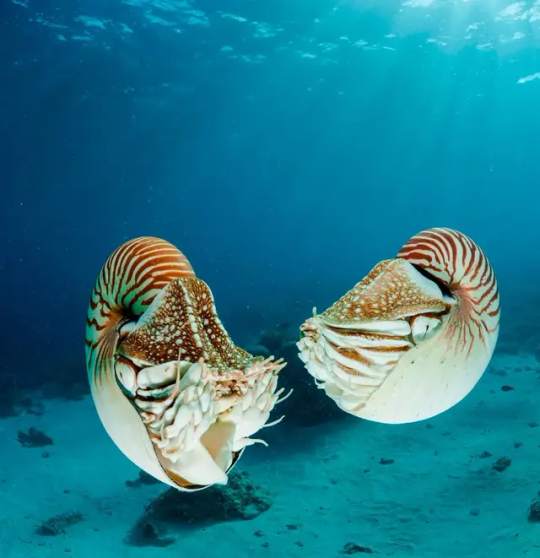

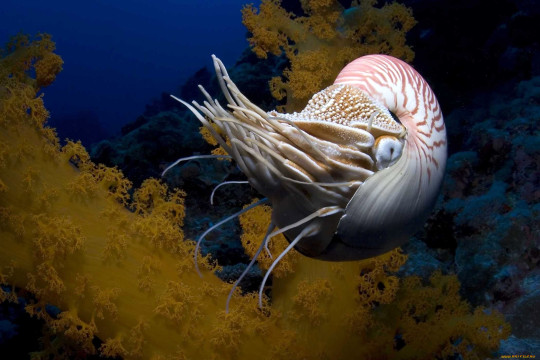
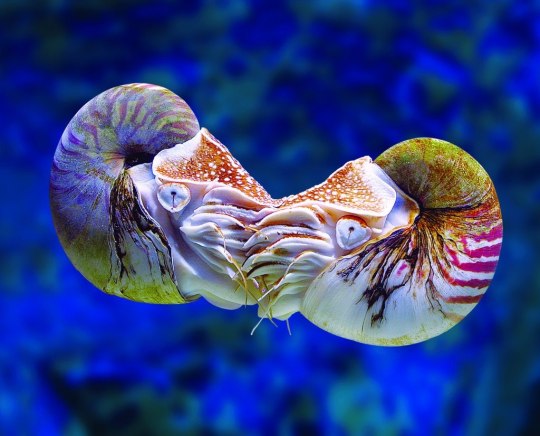
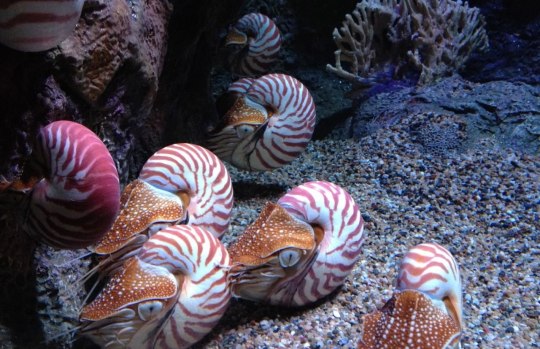
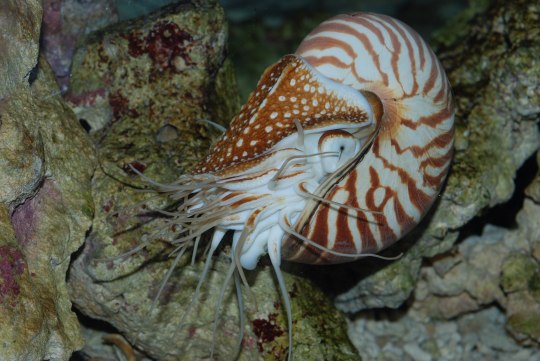
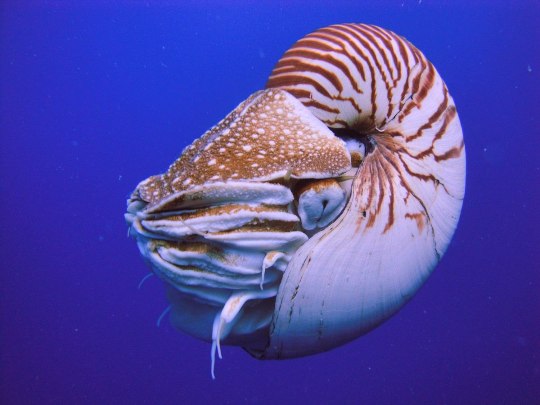
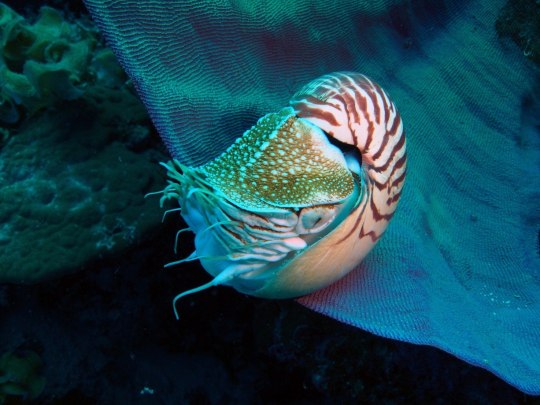




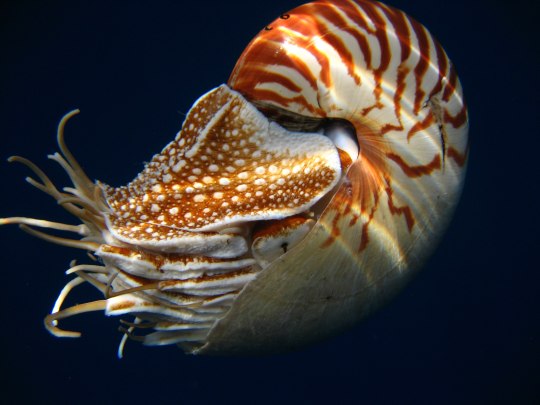
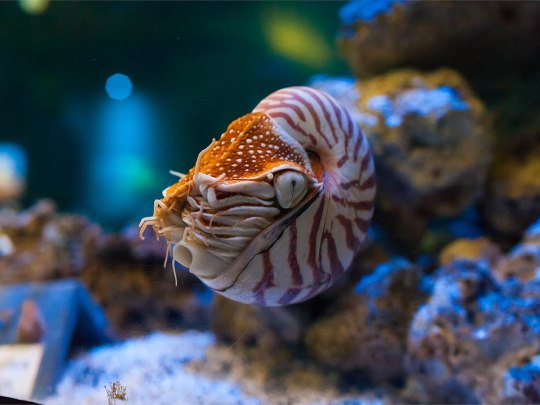

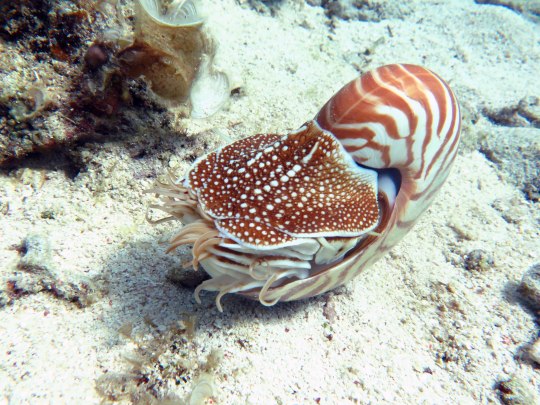
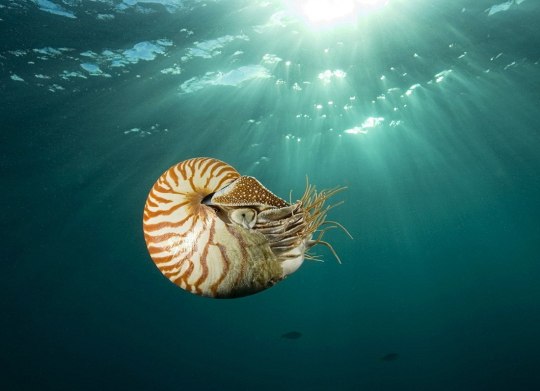

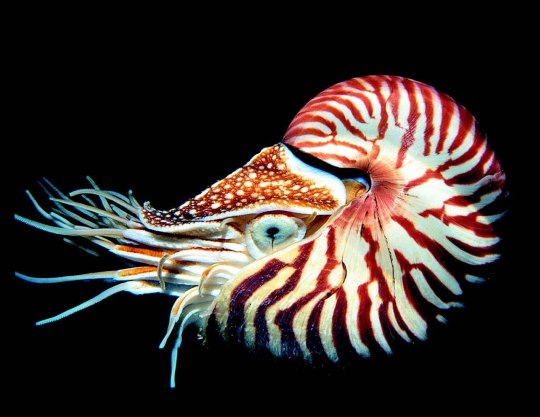

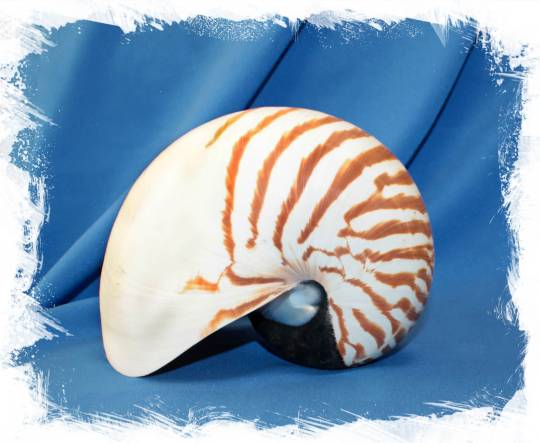
Наутилус (лат. Nautilus) — род головоногих моллюсков, которых относят к «живым ископаемым». Самый распространенный вид — Nautilus pompilius. Наутилусы относятся к единственному соврем��нному роду подкласса наутилоидей. Первые представители наутилоидей появились в кембрии, а его развитие пришлось на палеозой. Наутилиды почти вымерли на границе триаса и юры, но все же дожили до наших дней, в отличие от своих родственников аммонитов. Некоторые виды древних наутилусов достигали размера в 3,5 м. Представители самого крупного вида современных наутилусов достигают максимального размера в 25 см.
Спиральный «домик» моллюска состоит из 38 камер и «построен» по сложному математическому принципу (закон логарифмической прогрессии). Все камеры, кроме последней и самой большой, где размещается тело наутилуса с девятью десятками «ног», соединяются через отверстия между собой сифоном. Раковина наутилуса двухслойная: верхний (наружный) слой – фарфоровидный – действительно напоминает хрупкий фарфор, а внутренний, с перламутровым блеском – перламутровый. «Домик» наутилуса растет вместе с хозяином, который перемещается по мере роста раковины в камеру попросторней. Пустое жилище моллюска после его гибели можно встретить далеко от его места обитания – после гибели «хозяина» их раковины остаются на плаву и перемещаются по воле волн, ветров и течений.
Интересно, что двигается наутилус «в слепую», задом наперед, не видя и не представляя препятствий, которые могут оказаться на его пути.И еще одно удивительное качество этих древних обитателей Земли – у них потрясающая регенерация: буквально через несколько часов раны на их телах затягиваются, а в случае потери щупальца быстро отрастает новое.
Nautilus is a genus of cephalopods, which are classified as "living fossils". The most common species is Nautilus pompilius. Nautilus belong to the only modern genus of the Nautiloid subclass. The first representatives of the Nautiloids appeared in the Cambrian, and its development took place during the Paleozoic. The Nautilids almost died out on the border of the Triassic and Jurassic, but still survived to the present day, unlike their Ammonite relatives. Some species of ancient Nautilus reached a size of 3.5 m. Representatives of the largest species of modern nautilus reach a maximum size of 25 cm.
The spiral "house" of the mollusk consists of 38 chambers and is "built" according to a complex mathematical principle (the law of logarithmic progression). All chambers, except the last and largest, where the nautilus body with nine dozen "legs" is located, are connected through holes with a siphon. The nautilus shell is two–layered: the upper (outer) layer – porcelain–like - really resembles fragile porcelain, and the inner, with a mother-of-pearl luster - mother-of-pearl. The nautilus's "house" grows with its owner, who moves as the shell grows into a larger chamber. The empty dwelling of a mollusk after its death can be found far from its habitat – after the death of the "owner", their shells remain afloat and move at the will of waves, winds and currents.
Interestingly, the Nautilus moves "blindly", backwards, without seeing or imagining the obstacles that may be in its path.And another amazing quality of these ancient inhabitants of the Earth is that they have amazing regeneration: in just a few hours, the wounds on their bodies heal, and in case of loss of tentacles, a new one grows quickly.
Источник:://t.me/+t0G9OYaBjn9kNTBi, /sevaquarium.ru/nautilus/, /habr.com/ru/articles/369547/, //wallpapers.com/nautilus, poknok.art/6613-nautilus-molljusk.html, //wildfauna.ru/nautilus-pompilius, /www.artfile.ru/i.php?i=536090.
#fauna#video#animal video#marine life#marine biology#nature#aquatic animals#cephalopods#Nautilus#nautilus pompilius#living fossils#ocean#benthic#coral#plankton#beautiful#animal photography#nature aesthetic#видео#фауна#природнаякрасота#природа#океан#бентосные#головоногие моллюски#Наутилус#живое ископаемое#коралл#планктон
173 notes
·
View notes
Text



Epochtober Day 13: Upper Triassic (Nothosaurus) 🦎 #digitalart #procreate #digitalpainting #epochtober #paleoart #paleontology #triassic
74 notes
·
View notes
Text

A pair of dinosaur footprints of the ichnotaxon Anomoepus sp. from the Passaic Formation in a private quarry in New Jersey, United States. This Upper Triassic to Lower Jurassic aged ichnogenus possibly belongs to an early ornithischian of some kind. The footprints have been highlighted or stained for clarity and one of the cracked corners has been repaired. There is also a third footprint on the back of the slab.
#dinosaur#fossils#ichnotaxon#paleontology#palaeontology#paleo#palaeo#anomoepus#anomoepodidae#ornithischian#triassic#mesozoic#prehistoric#science#paleoblr#アノモエプス#恐竜#化石#古生物学
49 notes
·
View notes
Text

"The grandfather of all the crocodiles seems to have been Protosuchus, a saurian about 32 inches long, whose skeleton was found in Upper Triassic strata in North America."
Prehistoric Sea Monsters. Written by Dr. Josef Augusta. Illustrated by Zdeněk Burian. 1966.
Internet Archive
138 notes
·
View notes
Text
Round 1 - Phylum Brachiopoda

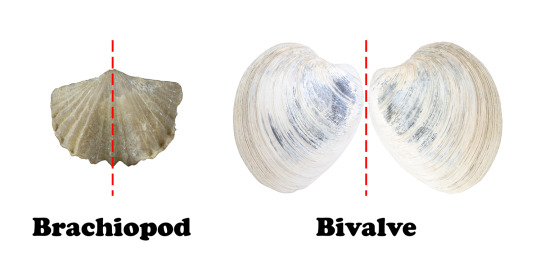


(Sources - 1, 2, 3, 4)
Brachiopoda is a phylum of animals that are superficially similar but entirely unrelated to bivalve molluscs, in that they have hard valves (shells) protecting their bodies. However, unlike bivalves, who have a left and right shell arrangement, brachiopods have upper and lower shells (trust me, it makes sense anatomically). Their shells are hinged at the rear, while the front end can be opened for feeding or closed for protection. Most brachiopods have a stalk-like pedicle which projects from an opening near their hinge and anchors the animal to the sea floor (see 3rd image). Some brachiopods use their pedicle to emerge and retract into a burrow. They are filter feeders, using a lophophore to feed. However, unlike bryozoans and entoprocts, their lophophore is U-shaped. Some species do not have an anus, instead combining solid waste with mucus and periodically "sneezing” it out. Brachiopod lifespans can range from 3 to 30+ years. They only live in the ocean, in areas with cold water and low light, and without strong currents or waves, Some are commonly known as “lamp shells.”
There are two major categories of brachiopod; articulate and inarticulate. Articulate refers to the tooth-and-groove structure at the hinge of the shell, which inarticulate brachiopods lack. Inarticulate brachiopods have larvae that look like miniature adults with extended lophophores (seen in gif below), which live as plankton for months before growing too heavy and sinking to the sea floor. Articulate brachiopods have larvae which look like blobs with a yolk sack and live as plankton for a few days before metamorphosing.
Brachiopods have existed since the early Cambrian, but lost about 2/3 of their once great diversity during the Permian-Triassic extinction event. Today there are about 100 living genera, though there are 5,000 fossil genera.

Propaganda under the cut:
Brachiopods hit their peak in the Paleozoic era, occupying many ecological niches and being the most abundant filter-feeders and reef-builders. After losing most of their diversity in the Triassic, they’ve lost this position to bivalves. But we must never forget the Old Kings of Shell.
The smallest living brachiopod, Gwynia, is only about 1 mm long and lives between grains of gravel.
The largest brachiopods known lived in the Carboniferous: Gigantoproductus and Titanaria could be 30 to 38 cm (12 to 15 in) wide. Today, most brachiopods range from 1 to 100 mm (0.04 to 3.9 in) long, with the largest being Magellania venosa.
Brachiopod flesh is apparently Not That Great, and not much preys on them. Even fossil brachiopods are rarely found with evidence of predation in the same way fossil bivalves are. Humans, however, do fish for one genera commercially, though on a small scale. Because of course we do.
Brachiopods are apparently very sensitive to pollution, and are good indicators of water quality.
Brachiopods are the state fossil of Kentucky. No specific species. Just all of them, I guess.
50 notes
·
View notes
Text

Day 1: Colossosuchus
An extinct genus of large mysteriosuchine phytosaur from upper late Triassic of India.
This is a new and differently challenging situation for October. So I have to skipped Inktober so I have to go practice with crocodilians and non-crocodilian archosaur type creatures.
Enjoy while I do sketching, and sketching is fun.
24 notes
·
View notes
Text
FOSSIL FRIDAY: Ceratites
Ceratitida is an order of ammonite from the upper Permian through the Triassic Period.

They are identified by the smooth saddle and serrated lobe suture patterns.

They are found in Europe, the Middle East, Russia, China, Papua New Guinea and the Great Basin of the western U.S. Essentially, the coastlines of Pangea.

MORPHOLOGY AND ECOLOGY
It is thought that the frilly, serrated lobes in the sutures evolved due to increased water pressure on shells. This implies that these ammonites, while still living in shallow seas, ventured out into deeper water in search of food.
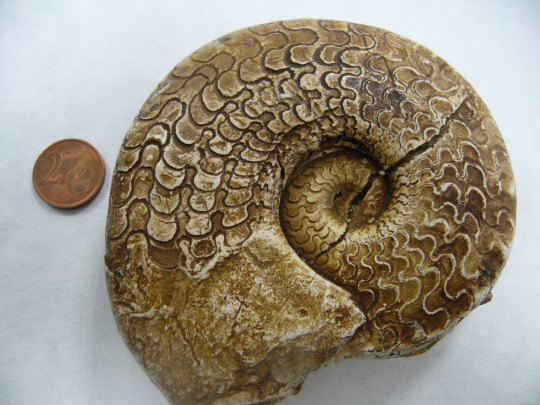
59 notes
·
View notes
Photo

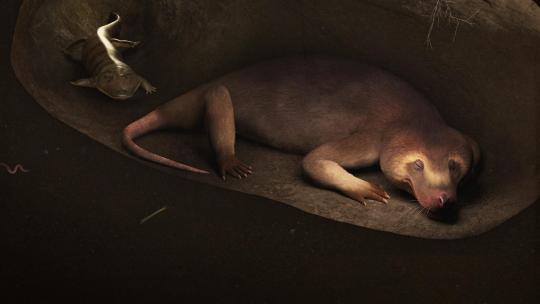
May’s Fossil of the Month - Thrinaxodon (Thrinaxodon liorhinus)
Family: Thrinaxodon Family (Thrinaxodontidae)
Time Period: Early Triassic (251-247 Million Years Ago)
At the end of the Permian period around 251 million years ago, the earth experienced the most extreme extinction event in its history (known as the Permian-Triassic Extinction Event or “The Great Dying”,) in which some 70% of terrestrial species and 81% of marine species were driven to extinction. As such, the period immediately following the Permian, the early Triassic, was a period of slow recovery as the descendants of the few survivors of the Great Dying began to adapt and diversify to fill the ecological niches left empty by the extinction of their previous occupants. Thrinaxodon liorhinus was one such survivor; a small (roughly 50cm/1.6 feet in length) species of cynodont synapsid (making it a close relative of mammals, but not a mammal itself), it inhabited what is now southern Africa and northern Antarctica (which were fused as part of a single landmass at the time) in the period immediately following the great dying, and was seemingly among the largest and most common carnivores of its time. Thrinaxodon’s survival was likely enabled at least in part due to its lifestyle; the discovery of individuals fossilized in the remains of burrows show that Thrinaxodon, like many similarly-sized mammals today, was a burrower, and the presence of distinct divisions on its spine to aid in flexibility suggests that, like many burrowing mammals and reptiles today, it may have possessed the ability to travel deeper underground and undergo hibernation or aestivation in order to endure prolonged periods of harsh weather conditions and resource scarcity. In life Thrinaxodon would have likely appeared somewhere between a large lizard and a small dog, with its leg bones and joints suggesting that it stood in a “semi-sprawling” posture mid-way between the belly-to-the-ground sprawling of most lizards and the elevated posture of most mammals, while its dog-like skull and sharp-tipped teeth (including prominent canines on both the upper and lower jaw) suggest that it was likely carnivorous, feeding on insects and/or smaller vertebrates. The discovery of the remains of several Thrinaxodon individuals, sometimes including juveniles, preserved in close proximity to one another suggests that members of this species likely provided parental care and may have also been social, and one unusual but extremely famous fossil burrow containing both an adult Thrinaxodon and an injured Broomistega putterilli (a small species of superficially salamander-like amphibian) showing puncture wounds from teeth too large to belong to the burrow’s owner suggests that, like the Gopher Tortoise and Giant Armadillo today, Thrinaxodon may have been a habitat engineer, with its burrows providing shelter for other species of animal (although it is also possible that the Broomistega had been washed into the burrow during a flood that killed both animals, or that the Thrinaxodon had stolen the injured Broomistega from the larger carnivore that wounded it.)
--------------------------------------------------------------------------
Image Sources: https://commons.wikimedia.org/wiki/File:Thrinaxodon_liorhinus_BP_1_7199.jpg
and
https://www.pbs.org/video/the-oddest-couple-in-the-fossil-record-rcehau/
#thrinaxodon#thrinaxodon liorhinus#synapsid#Synapsids#non-mammalian synapsids#cynodont#cynodonts#zoology#biology#paleontology#paleobiology#animal#animals#wildlife#prehistoric wildlife#prehistoric animals#fossil vertebrates
125 notes
·
View notes
Text
New reptile shows dinosaurs and pterosaurs evolved among diverse precursors
Published 16th August 2023
A well-preserved partial skeleton of a new lagerpetid, Venetoraptor gassenae, from the upper Triassic of Brazil increases understanding of the diversity in pterosaur and dinosaur early ancestors.

Venetoraptor gassenae reconstruction and holotype material
Source:
55 notes
·
View notes
Text

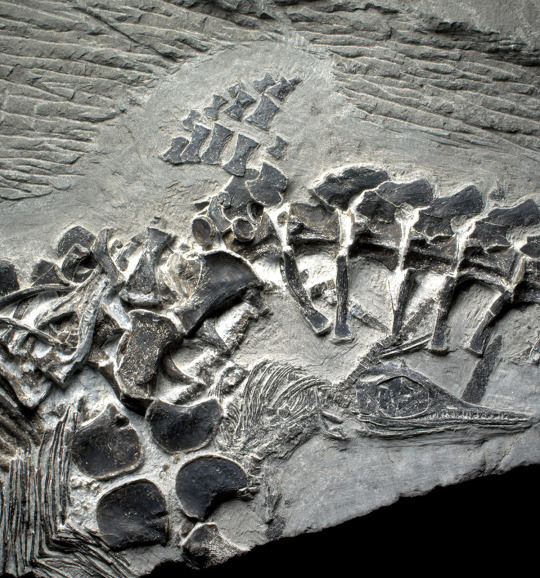
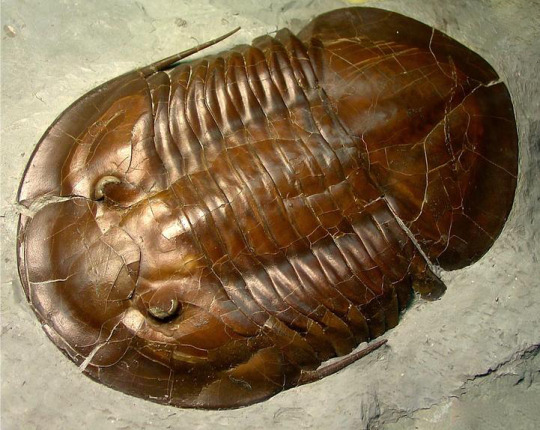
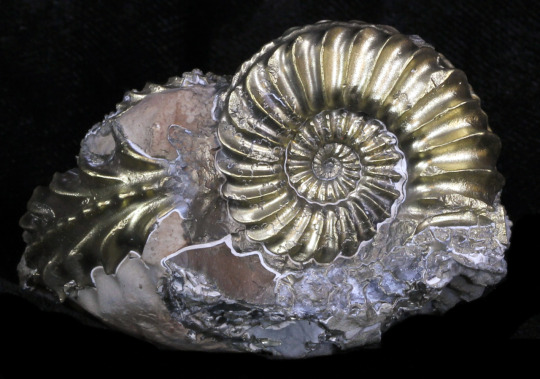
Pachycephalosaurus skull - Montana - Late Cretaceous
birthing Chaohusaurus ichthyosaur - China - Triassic
Isotelus maximus trilobite - Ohio - Upper Ordovician
pyritized Pleuroceras ammonite - Forcheim, Germany - Jurassic
69 notes
·
View notes
Text
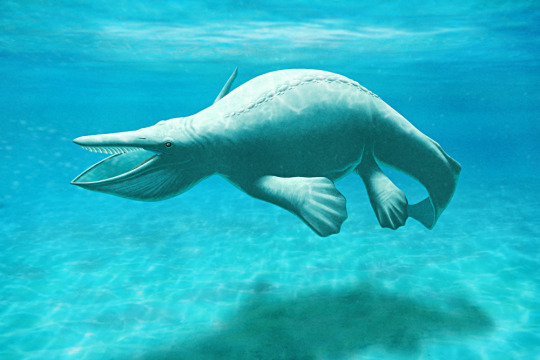
Hupehsuchians were small marine reptiles closely related to ichthyosaurs, known only from the Early Triassic of southwestern China about 249-247 million years ago. They had toothless snouts, streamlined bodies, paddle-like limbs, and long flattened tails, along with a unique pattern of armor along their backs made up of overlapping layers of bony osteoderms.
Hupehsuchus nanchangensis was a mid-sized member of the group, about 1m long (3'3"). Newly-discovered fossils of its skull show that its long flattened snout had a distinctive gap between the bones (similar to the platypus-like snout seen in its relative Eretmorhipis) with an overall shape surprisingly convergent with that of modern baleen whales – suggesting that this hupehsuchian may have been a similar sort of filter-feeder.

Hupehsuchus skull compared to a modern minke whale [From fig 2 & fig 3 of Fang et al (2023). First filter feeding in the Early Triassic: cranial morphological convergence between Hupehsuchus and baleen whales. BMC Ecol Evo 23, 36. https://doi.org/10.1186/s12862-023-02143-9]
Grooves in the bones along the outer edges of its upper jaws may be evidence of filtering structures similar to baleen, although with no soft-tissue preservation we don't know exactly what this would have looked like. Its slender flexible lower jaws probably also supported a large expandable throat pouch, allowing it to filter plankton out of larger volumes of water.
———
NixIllustration.com | Tumblr | Patreon
#science illustration#paleontology#paleoart#palaeoblr#hupehsuchus#hupehsuchia#ichthyosauromorpha#reptile#marine reptile#art#triassic weirdos
602 notes
·
View notes
Text
I really really need to practice my paleoart so I'm gonna try Archovember. (List of day prompts by @saritawolff is under the cut!) Day 1 is your choice, so I chose the leggiest of boys, Terrestrisuchus gracilis! Ignore the goofy eye, its been a while since I tried traditional art and I got too excited to erase the sketch lines and smudged it ;-;

T. gracilis lived during the Upper Triassic period, and contrary to its rather dinosaur-like appearance, it is actually one of the earliest known crocodylomorphs! Some estimates have it at about 1 meter (3 ft) long. It had long, thin legs and a thin frame. Its head was long and slender- perfect for catching tasty bugs! There seems to still be discourse over if it was a quadruped, a biped, or a mix of both (think like hadrosaurs!).


23 notes
·
View notes
Text
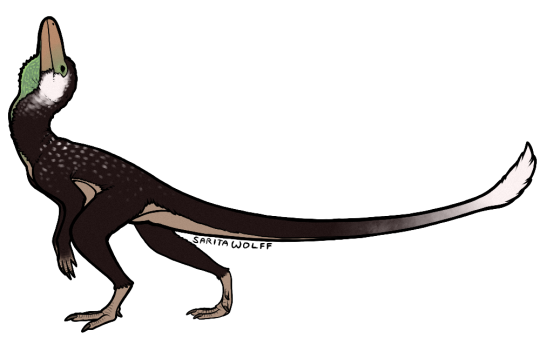
#Archovember Day 26 - Ixalerpeton polesinensis
The Triassic lagerpetids were once thought to be early dinosauromorphs, but recent fossil evidence suggest that they were actually pterosauromorphs… either closely related to pterosaurs or even ancestral to them! Ixalerpeton polesinensis was a lagerpetid from Late Triassic Brazil, a locale that would eventually become a hotspot for pterosaurs. Like other lagerpetids, it had long hind legs with well-developed muscles, but it lacked the neural spines that suggest hopping locomotion as in Lagerpeton. It was small and agile, likely using its long legs to chase and leap after insects.
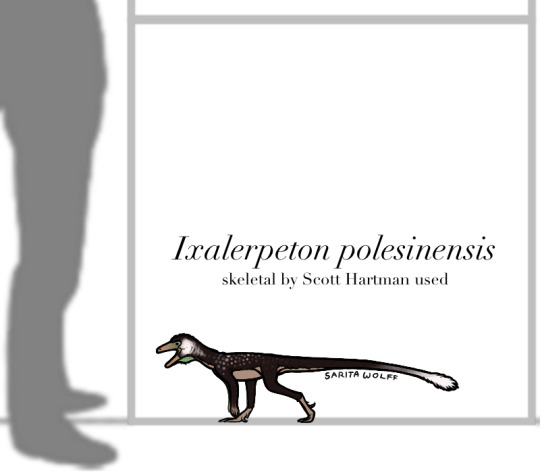
In the Upper Santa Maria Formation, Ixalerpeton would have had to watch out for large predatory pseudosuchians like Rauisuchus and herrerasaurids like Staurikosaurus and Gnathovorax. It also lived alongside early aetosaurs Aetobarbakinoides and Aetosauroides, silesaurs like Amanasaurus, and basal sauropodomorphs Buriolestes and Saturnalia. There were also a variety of cynodonts, like Gomphodontosuchus and Prozostrodon, and the temnospondyl amphibian Compsocerops.
#my art#SaritaDrawsPalaeo#Ixalerpeton polesinensis#Ixalerpeton#lagerpetid#pterosauromorphs#archosaurs#archosauromorphs#reptiles#Archovember#Archovember2023
19 notes
·
View notes
Text
Triassic Double Feature
Just weeks ago I remissed the lack of new croc taxa, seems I spoke to soon because they are being pumped out like crazy right now. For simplicity, I will cover two of the recent sorta-crocs together as neither are super extensive and they match in overall time.
These two new genera are the aetosaur Kryphioparma and the phytosaur Jupijkam. Pictured below the fossils of both with reconstructions of close relatives (art by Brian Engh and Gabriel Ugueto).
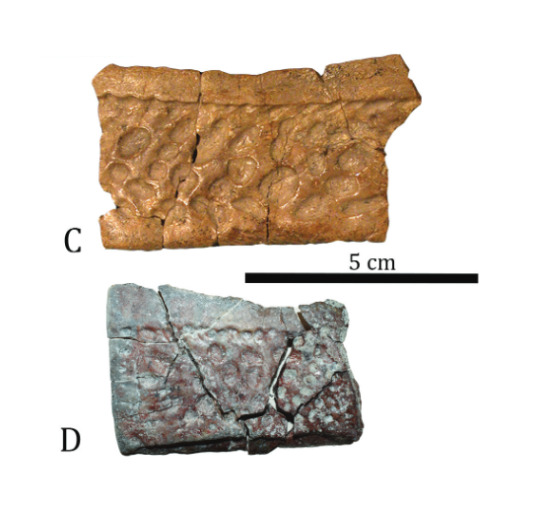

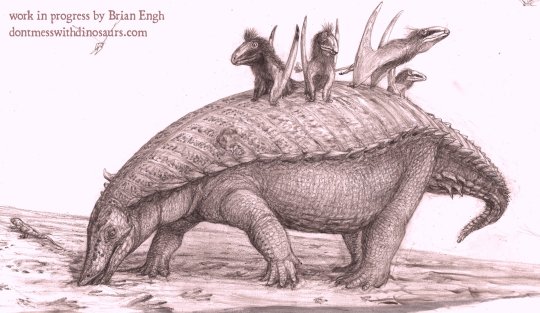

I'll start with Kryphioparma, which I wager is the less interesting of the two. Kryphioparma was an aetosaur, which are effectively early pseudosuchians that evolved a body type very similar to what nodosaurs did later. Heavily armored, sometimes with prominent spikes and herbivorous.
Kryphioparma is only known from four isolated and incomplete osteoderms, and though these are actually diagnostic and highly distinct, it does mean there's not super much to say. Hell, the scientific name literally means "mysterious shield" in reference to how little we know.
Regardless, scientists did determine two things. 1) It's a typothoracine aetosaur, narrowing down its placement to one of the two main branches. This means its closer related to Typothorax (with its armored cloaca) than to Desmatosuchus (with its shoulder spikes). 2) The second thing we know is that it wasn't alone. No, the localities that yielded its bones (Placerias Quarry and Thunderstorm Ridge) actually preserve a highly diverse aetosaur fauna, including Calypsosuchus, Tecovasuchus and two species of Desmatosuchus. All images by Jeff Martz.

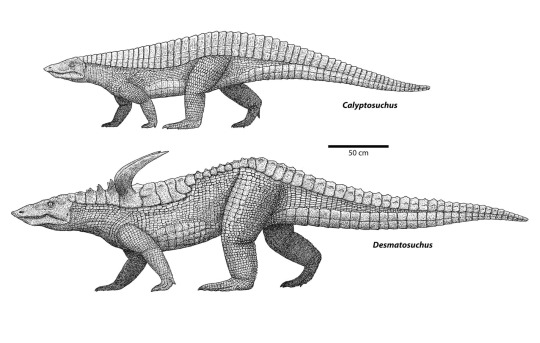
Now the arguably more exciting find is that of Jupijkam, a type of phytosaur, which are archosaurs superficially resembling today's crocodiles. Now when I grew up, phytosaurs used to be considered to be entirely unrelated to crocs, being a type of archosaur believed to have diverged prior to the bird-croc split. However, it would appear that recent studies suggest that they could actually be true croc-line archosaurs, potentially being the earliest diverging group of Pseudosuchian.
Jupijkam is from the Rhaetian-Norian Blomidon Formation of Novia Scotia, Canada. This not only makes it one of the youngest, but also one of the northern-most known phytosaurs to date. It's scientific name, Jupijkam, is actually derived from the name given by the local Mi’kmaq people to their version of the horned serpent.
How Jupijkam is related to other phytosaurs is a bit wonky. Now generally, its recovered as a mystriosuchine, which isn't exactly a surprise given that most phytosaurs fall into this category. It's placement however shifts ever so slightly depending on the precise methods and characters used. 2/4 times it was found to be most closely related to Rutiodon (the phytosaur shown at the very start), once alongside the Indian Volcanosuchus and once to its exclusion. One tree simply results in a big polytomy which isn't really helpful, and one time it was found as a much more derived form related to Mystriosuchus. Whatever the case, additional finds both of other phytosaurs and Jupijkam specifically might clarify this in the future. Currently however, it seems that this form is not related to all the other American species of its time, suggesting it held out till the late Triassic independently. Which is pretty neat. Below you can see a comparisson between Jupijkam and some other slender-snouted phytosaurs, courtesy of Brownstein 2023. A is Jupijkam, B is Rutiodon and C is Machaeroprosopus

Really that wraps things up already, two new genera, both Triassic, both (potentially) early Pseudosuchians. A little bit out of my usual focus but very interesting none the less. Definitely gotta make another post soon since they just dropped yet another new one (a metriorhynchid), but I gotta read that paper first. Speaking of which A new aetosaur (Archosauria: Pseudosuchia) from the upper Blue Mesa Member (Adamanian: Early–Mid Norian) of the Late Triassic Chinle Formation, northern Arizona, USA, and a review of the paratypothoracin Tecovasuchus across the southwestern USA (escholarship.org) A late-surviving phytosaur from the northern Atlantic rift reveals climate constraints on Triassic reptile biogeography | BMC Ecology and Evolution | Full Text (biomedcentral.com) plus the respective Wikipedia pages Kryphioparma - Wikipedia Jupijkam - Wikipedia
#pseudosuchia#phytosaur#aetosaur#croc#palaeoblr#paleontology#prehistory#triassic#chinle formation#Kryphioparma#Jupijkam#long post#science#reptiles
40 notes
·
View notes